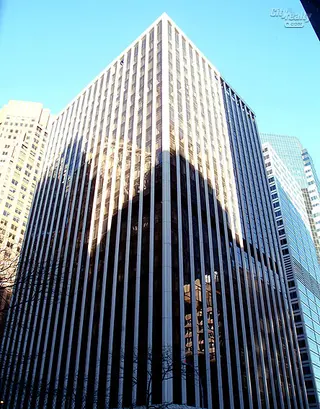 Carter Horsley
Carter HorsleyDec 23, 2011
Carter's Review
In 1969, Emery Roth & Sons designed this 22-story structure at 10 Hanover Square in the Financial District as an office building.
It was acquired by The Witkoff Group and converted to 493 rental apartments in 2005. Subsequently, it was acquired in 2011 by UDR, Inc., of Denver for $260.8 million
BG Studio International and Schuman Lichtenstein Claman & Efron were the architects for the conversion.
The building is also known as 110 Pearl Street and 76 Water Street.
Bottom Line
Across from the very handsome India House and not far from the South Street Seaport and Battery Park, this handsome building has a impressive broad staircase, a bicycle room and a roof deck.
Description
The building has white piers and bronze-colored windows and faces India House with an 8-step-up broad staircase with four banisters flanked by sloping lawns with sidelights.
The building has a front arcade and more than 40,000 square feet of retail space.
Amenities
The building has a 24-hour doorman, a concierge, valet services, a live-in superintendent, storage, a roof deck, a lounge with a fireplace, billiard table and catering kitchen, bicycle room, a rock-climbing wall, and laundry facilities.
Pets are permitted.
Apartments
Apartment 21T is a studio unit with an 11-foot-wide home office, a pass-through kitchen and a 17-foot-living/dining room.
A one bedroom unit has a long entry foyer opposite a 16-foot-wide home office and a 21-foot-long living room with an open kitchen with an island.
Penthouse B is a one-bedroom duplex with a home office and a terrace.
Penthouse I is a two-bedroom duplex an open kitchen and a very large terrace off the upstairs bedroom.
Some apartments are furnished by Oakwood Worldwide that acquired the ExecuStay corporrate housing brand from Marriott International in 2012.
History
According to the New York City Parks Department, "the land in and around this park has been used continuously since at least 1637 when it was part of a public street and fronted directly on the East River."
"By 1730 this area was known as Hanover Square in tribute to the House of Hanover which had acceded to the English throne in the person of George I in 1714. For much of the 18th century, Hanover Square was the center of New York's printing trade and retail business. Local shops sold imported books, clothing, glassware, hardware, and furniture, as well as wine, tobacco, and tea. The Bank of New York moved its headquarters to the square in 1787.
"The Great Fire of 1835 destroyed almost all of the buildings in the area. In time, the area was rebuilt as a commercial and financial center, which it remains to this day. The landmarked India House building (originally the Hanover Bank) is the only surviving example of the many Italianate banks erected in the financial district in the 1850s….
A 1979 rededication of the park also celebrated the installation of the over life-size portrait statue of Abraham De Peyster. Born in New Amsterdam, De Peyster (1657-1728) was one of the city's wealthiest merchants who became mayor. The statue was removed, however, to accommodate the redesign of Hanover Square as the British Memorial Garden that created to commemorate the 67 Britons who died in the terrorist attacks on the World Trade Center in 2001. The new park space features hand-carved stone from Scotland, plantings from Prince Charles's estate, and iron bollards from London. The garden was completed in June, 2008.
India House was built in Italianate style in 1854 for the Hanover Bank and its tenants included W. R. Grace & Co., and the New York Cotton Exchange.
India House eventually became a club organized by Williard Straight whose members had interests of some sort in the West Indies.

- No Fee Rental built in 1971
- Converted in 2005
- Located in Financial District
- 493 total apartments 493 total apartments
- Doorman
- Pets Allowed
 6sqft delivers the latest on real estate, architecture, and design, straight from New York City.
6sqft delivers the latest on real estate, architecture, and design, straight from New York City.
